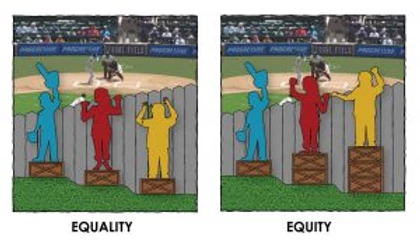Equality Versus Equity: An Illustrated Explanation of Why We Need Feminism


Why is it called “feminism” and not “equalism”? Why can’t “meninism” exist if “feminism” does? Why is there such a fuss about women’s empowerment when women and men are already considered equal by most laws in so many places?
The answer to these questions is this: there is a difference between equality and equity.
Consider the first panel in the picture above. There are three individuals who want to watch a cricket match: let’s call them Blue, Red and Yellow. These individuals are of equal height, equal ability, equal intelligence. All three stand before a fence. All three are given a box to stand on so they can see the action on the other side.
This is equality – everyone gets treated the same way. A simple solution? Yes. Effective? Almost. Inclusive? Not quite. And this is where the problem lies.
While one box is enough for Blue to get a clear view of the match, Red can just about peer through and Yellow, despite the box, can see nothing on the other side. The reason for this has nothing to do with the individuals themselves – rather, the barrier is higher for Yellow than for Blue. Look into the picture and see that Blue is standing on higher ground to begin with – that, along with the relatively low barrier of the fence, means that the external environment of Blue is enabling and empowering. Meanwhile, the external situation of Yellow causes a significant disadvantage in viewing the match – the ground is lower, while the fence is at its highest. One box was enough for Blue, but not for Yellow. The idea of equality did not give equal results or equal satisfaction.
Now look at the second panel: give Red one more box, give Yellow two more boxes, and everyone can watch the match. This is equity over equality. Equity is giving everyone what they need, based on their individual positions, in order to achieve success.
In the world we live in today, women in most places are in the position of Yellow, while men have the privilege of being in the place of Red or Blue. That is to say, while men and women have the same abilities, the same intelligence, women often face more social barriers to achieving success. For example, a joint report by the World Bank and UN Women shows that women between the age of 20-34 are more likely to be below poverty line than men, due to jobs that do not provide for them in the event of childbearing, motherhood and domestic duties, the burden of which falls more heavily on a woman’s shoulders than a man’s. It also states that social situations like divorce, widowhood and separation affect women more negatively than men – in fact, divorced women are twice as likely to be poor compared to divorced men of the same age. Women make up more than two-thirds of those who are illiterate, worldwide. Thus, the barriers women as a whole face – illiteracy, poverty and more – are significantly more difficult to overcome compared to those men face to reach the same level of success; the fence is higher for most women, so to speak.
We have to first acknowledge the data: more women are at a disadvantage that makes it harder for them to gain the same opportunities that most men have. Equal opportunity can only exist if equity exists – if women’s rights, safety and development are given a higher level of focus so more women can get access to the same resources as men. This is why we need feminism: not to bring men down, but to uplift women so that both have access to what they need.
By Diya Radhakrishna
